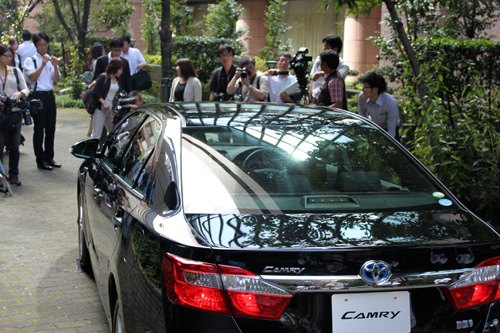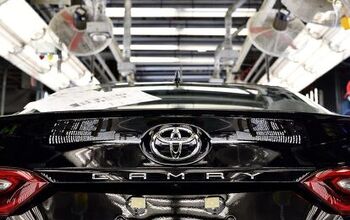The New 2012 Camry (Japanese Spec)

Today, the 7th generation Camry was shown to the Japanese press in Tokyo. It was weeks after the new Camry had been shown in the U:S. and tested by the creme de la TTAC. Actually, it feels like Japan was the last country to get a Camry launch. And honestly, the country deserves short shrift: Less than one percent of the total worldwide Camry production (692,000 in 2010) is sold in Japan. With 14 million made up to date, the Camry is one of the world’s best selling cars, and the Japanese snub their noses at it. More than half of the production goes to the U.S., 22 percent are sold in China, the rest of the world takes the rest.
Frank Greve who had flogged manufacturer largesse with journalists would love Japanese car launches, especially those by Toyota. No business class flights to Scotland, no private planes to Sicily, no free iPads. The only thing you get for free at Toyota is an invitation and a bottle of water when it’s hot. They don’t need freebies: The A-list of the media, from the Nikkei to Dow Jones, from Reuters to NHK shows up, they report what they see and usually hit “send” before the event is over.
Today’s launch was a masterpiece of essentialism. It took place in a drab meeting room of the Japan Auto Manufacturers Association. Test drives?
Forget it: There was exactly one black Camry parked next to the building, and it wasn’t available for driving. Honestly, I like these frugal events. They are real press conferences, not a sales show.
And we could clear up something that had vexed the Best and Brightest for a while: The was a rumor going around that the U.S. would get a different Camry that “the Asians.” Let’s have a look, at least as far as a part of Asia is concerned that is called Japan.
From the front: Not so much difference:
From the side: Not so much difference.
Under the hood: Whoa. All new Camry models for the Japan market are propelled by the Toyota Hybrid System (THS) II. It uses a newly developed 2.5-liter Atkinson engine (2AR-FXE) with reduction gear. Hybrids account for 14 percent of all regular cars sold in Japan, so Toyota offers the Camry in Japan as hybrid only.
This is its battery.
“The Camry doesn’t sell as much here as it does in the States, so we decided to focus on fuel economy,” deputy chief engineer Keiichi Yoneda explained. The car gets 26.5 km/l under the Japanese Ministry of Land, Infrastructure, Transport and Tourism (MLIT) test cycle and 23.4 km/l under the JC08 test cycle. That would be 62.3 mpg and 55 mpg respectively – definitely non-EPA. Still, the JDM Camry is basically the USDM Camry Hybrid.
There is one thing Americans won’t get, and that’s Made in Japan Camrys. Most U.S. Camrys are made in Kentucky. However, in the past a few Japan-made Camrys found their way stateside. This will stop, as it was announced at the press conference.

Bertel Schmitt comes back to journalism after taking a 35 year break in advertising and marketing. He ran and owned advertising agencies in Duesseldorf, Germany, and New York City. Volkswagen A.G. was Bertel's most important corporate account. Schmitt's advertising and marketing career touched many corners of the industry with a special focus on automotive products and services. Since 2004, he lives in Japan and China with his wife <a href="http://www.tomokoandbertel.com"> Tomoko </a>. Bertel Schmitt is a founding board member of the <a href="http://www.offshoresuperseries.com"> Offshore Super Series </a>, an American offshore powerboat racing organization. He is co-owner of the racing team Typhoon.
More by Bertel Schmitt
Latest Car Reviews
Read moreLatest Product Reviews
Read moreRecent Comments
- Zerofoo No.My wife has worked from home for a decade and I have worked from home post-covid. My commute is a drive back and forth to the airport a few times a year. My every-day predictable commute has gone away and so has my need for a charge at home commuter car.During my most recent trip I rented a PHEV. Avis didn't bother to charge it, and my newly renovated hotel does not have chargers on the property. I'm not sure why rental fleet buyers buy plug-in vehicles.Charging infrastructure is a chicken and egg problem that will not be solved any time soon.
- Analoggrotto Yeah black eyeliner was cool, when Davey Havok was still wearing it.
- Dave M. My sweet spot is $40k (loaded) with 450 mile range.
- Master Baiter Mass adoption of EVs will require:[list=1][*]400 miles of legitimate range at 80 MPH at 100°F with the AC on, or at -10°F with the cabin heated to 72°F. [/*][*]Wide availability of 500+ kW fast chargers that are working and available even on busy holidays, along interstates where people drive on road trips. [/*][*]Wide availability of level 2 chargers at apartments and on-street in urban settings where people park on the street. [/*][*]Comparable purchase price to ICE vehicle. [/*][/list=1]
- Master Baiter Another bro-dozer soon to be terrorizing suburban streets near you...










































Comments
Join the conversation
I'm surprised at all the negative comments about the 2012 Toyota Camry. The Toyota Camry is simply the dominant mass market big sedan for the 21st century. It does the job that the Chevrolet Impala used to do. Both the 70s Impala and the current Camry LE have soft suspensions and over boosted power steering suitable for interstate driving. I'm glad that Toyota has found a way to give drivers around the world the option of the Impala experience, but with much better fuel economy.
Man, looking at the naked battery like that I'm rather surprised they couldn't find some way to sink it a little. Pretty clear that if they went with a run-flat they could have done it but I'm guessing the ride quality sacrifices turned them off from that. Still kinda surprising they didn't sink the components up top sticking out.